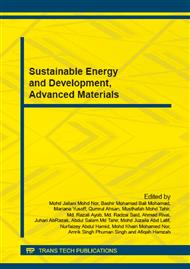p.15
p.20
p.26
p.32
p.38
p.44
p.49
p.53
p.59
Influence of Surface Treatment on the Surface Energy of Tungsten Carbide Inserts
Abstract:
The effect of substrate cleaning using ultrasonic cleaner on tungsten carbide was investigated. The surface energy of the substrate was measured using two liquids with dominant polar and dominant dispersion components which were distilled water (DI) and methylene iodide. Owens-Wendt method was carried out to calculate the surface energy of the substrate. The result showed that the cleaning process using solvent B (alkaline, DI, acid, DI, DI, alcohol) for 20 minutes without the wiping process led to the highest surface energy of 126.3399 dyne/cm with the polar component of 80.538 dyne/cm. Findings from this research suggested that type of solvent, cleaning time, and interactions among solvent type, cleaning time, and wiping process significantly influenced surface energy of the substrate.
Info:
Periodical:
Pages:
38-43
Citation:
Online since:
November 2014
Authors:
Keywords:
Price:
Сopyright:
© 2015 Trans Tech Publications Ltd. All Rights Reserved
Share:
Citation:


